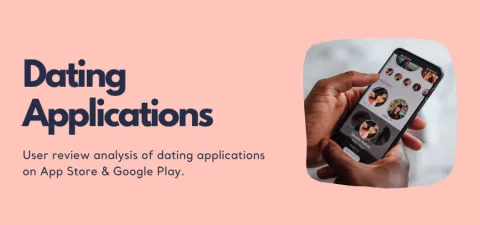Understanding Freelance Apps Through Customer Feedback Analysis
Dec 08, 2025 - 13 minute read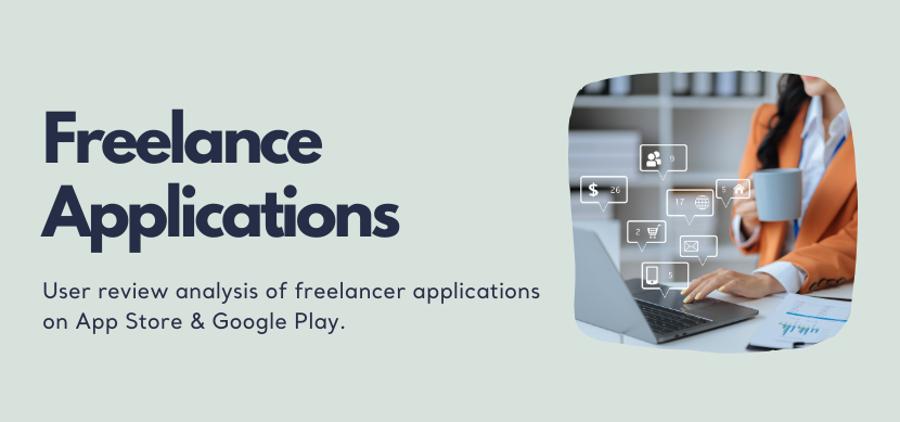
One evening, you’re hanging out with your friends, deep in conversation, when one of them says, "You really have an amazing talent; it would be so great if you opened it up to the world!" At that moment, something clicks. You ask yourself: Why not? Maybe that idea you've always thought about but never had the courage to pursue is finally taking shape in your mind. "I could start my own business, I could be my own boss." On your way home, these thoughts keep racing through your mind. You pick up your phone and start researching different freelance platforms. As you scroll through Upwork, Freelancer, Fiverr, you realize you’re getting lost in a universe full of millions of freelancers worldwide. But at some point, you ask yourself: Is choosing the right platform really that easy? Each one promises something different, and it becomes harder to determine which one suits you best.
This is where user feedback comes in. Using Kimola data analysis tool, we examined the user reviews of popular freelance platforms. This analysis reveals critical insights, such as which platform is more profitable, commission rates, client quality, and user experiences. For employers and freelancers, choosing the right platform is now much easier!
Methodology
In order to gain a deeper understanding of how users experience Upwork, Freelancer, and Fiverr, we turned to the most valuable source of insights: customer feedback. By analyzing real user reviews, we can uncover not only what works on these platforms, but also where users face challenges, what they expect, and what drives their decisions to continue using (or abandon) the services.
For this analysis, we used Kimola's powerful analysis tool to examine the most recent 250 reviews of each platform, collected from Google Play and the App Store. We uploaded the links to the system and conducted a thorough review, categorizing each piece of feedback with multiple labels to capture various aspects of the user experience. This approach allowed us to assign sentiment scores to different labels, which helped us identify key themes, recurring issues, and standout features for each platform.
Our analysis goes beyond raw data and statistics—it also incorporates users’ emotional reflections, providing a richer understanding of their experiences. Through this approach, we can highlight the differences between Upwork, Freelancer, and Fiverr not just from a numerical standpoint, but by considering how users truly feel about the platforms.
Let’s dive deeper into the insights provided by Kimola and explore what users are saying about these platforms!
What Motivates Users to Choose Freelance Platforms?
Freelance platforms like Upwork, Freelancer, and Fiverr have become essential tools for users, offering diverse ways to meet their professional and personal goals. According to customer reviews and data from Kimola, there are several key motivations driving users to engage with these platforms:
1. Finding Work and Career Growth:
Freelancers turn to these platforms to access job opportunities across various fields. Upwork, in particular, is favored for remote job options, while Fiverr offers a quick way for new freelancers to find clients. Users are also motivated by the potential for career development through diverse projects that help build skills and portfolios.
2. Managing Jobs and Client Communication:
Freelancers use these platforms to manage job applications, submit proposals, and communicate with clients. Upwork users, for example, value the ease of tracking job applications and interacting with clients, which helps in negotiating terms and resolving project-related issues. Communication tools are crucial for maintaining smooth, ongoing client relationships.
3. Payment and Cost Considerations:
Payment processing is a significant factor for freelancers. While platforms facilitate transactions, many users face issues such as high commission fees, withdrawal difficulties, and the cost of applying for jobs (like Upwork's "connects"). Freelancers seek platforms with transparent and user-friendly payment systems to ensure a steady income stream.
4. Skill Development and Networking:
For many, freelance platforms serve as a way to gain experience, enhance skills, and grow professionally. Additionally, these platforms offer opportunities for networking with clients and other freelancers, expanding their professional reach in an increasingly competitive market.
Explore Freelance Apps in Depth with Kimola Data Analysis
The Kimola data analysis tool reveals the strengths and weaknesses of freelance platforms based on user reviews. The analysis highlights the most frequently mentioned issues, providing a detailed breakdown of positive and negative evaluations of each platform. Let’s now examine Fiverr, Freelancer, and Upwork based on user experiences.
Fiverr: Easy to Use, Weak Customer Support
Fiverr has a user-friendly structure, with 79% of users praising the overall ease of use of the platform. However, the satisfaction rate with customer support is only 11%. While users mention that Fiverr offers a quick way to find work for new freelancers, account suspensions, slow customer service responses, and issues with payment processes are among the most criticized aspects. Moreover, high commission rates and fake job listings negatively affect users' income and trust.
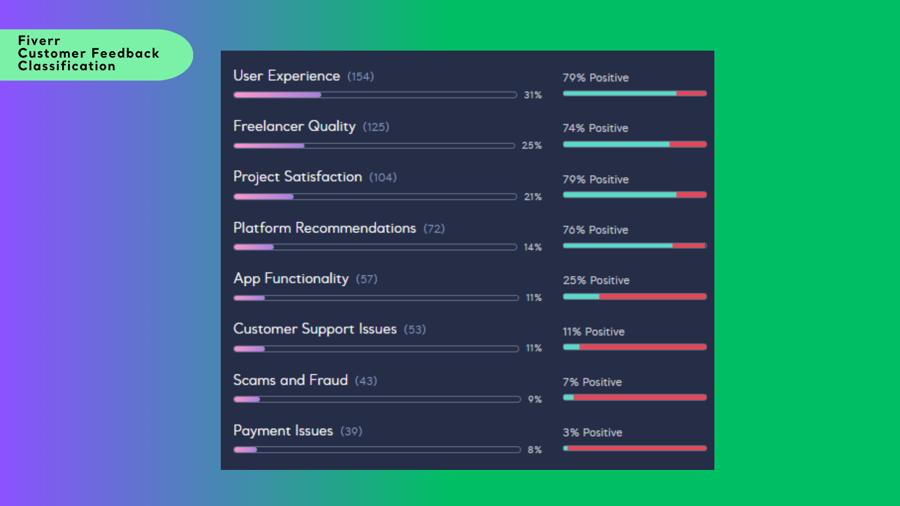
Freelancer: Rich Job Options, Technical Issues
Freelancer offers a wide range of job opportunities but receives significant criticism for technical glitches. Only 3% of users find the app's performance satisfactory, with the rest frequently facing crashes, slowdowns, and error messages. There are many negative reviews about payment issues. While the platform is successful in connecting employers and freelancers, users frequently mention that communication with customer support is difficult.
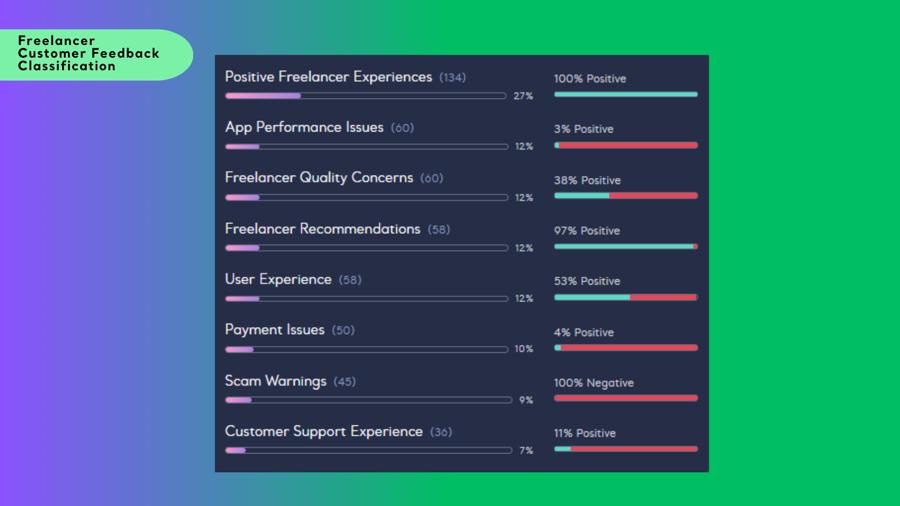
Upwork: Quality Employers, High Costs
Upwork stands out for its quality employers and long-term job opportunities. 61% of users are satisfied with the job opportunities on the platform. However, Upwork’s “Connects” system, which requires payment before applying for a job, is seen as unfair. Without purchasing Connects, freelancers are restricted in their ability to apply for jobs. There are also frequent complaints about fake job listings and fraud cases. Satisfaction with the payment and commission system is only 1%. Users believe that the platform's customer service should be more accessible and that payment processes should be made more secure.
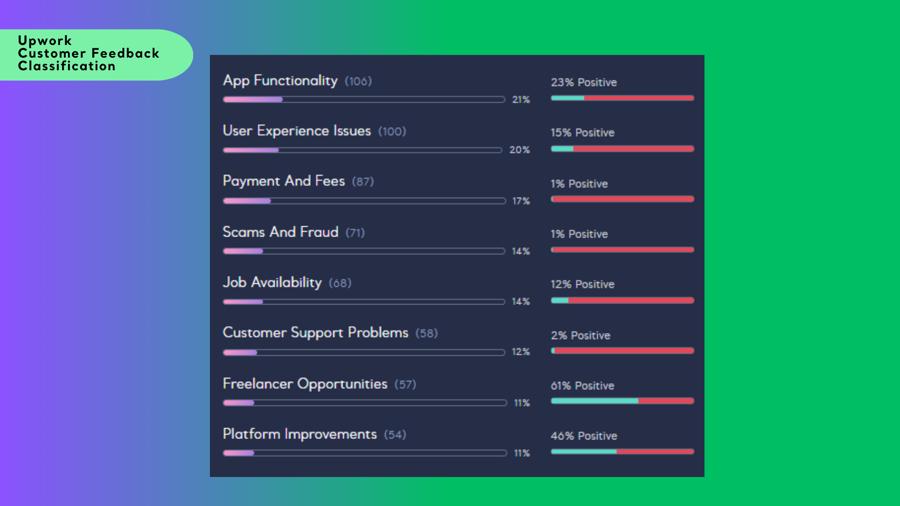
Who Uses These Apps?
First and foremost, it can be fun to understand who uses these platforms. After all, each app has its own personality, right? Based on the Buyer Persona analysis we conducted at Kimola, let’s explore the users of these platforms through various “personas.” Let’s see who the most extraordinary and typical users of these apps are:
1. Optimistic Newbie (31%) – The Dreamer with High Hopes
The one who has just taken their first steps into the freelance world, full of enthusiasm and thinking, “I can handle this!” They’re in full-on beginner excitement, yet they still keep their optimism intact despite the platform’s complexity, the lost points in the connect system, and the unknown labyrinths of the platform. Every time they say, “This time, I’ll succeed!” and dive into the work. After all, they’re young and energetic, right?
2. Frustrated Freelancer (30%) – The Reality Check Seeker
Who initially thought “Freelance work is like a paradise!” but eventually finds more problems in every job. Fake job postings, low wages, communication issues with clients... In short, disappointments flow like a flood. “Just one more job, please!” as they lose a little more morale with each new job posting on the platform. This character, hoping for good customer support and quality work, now looks at every project with the thought “Is this a scam?”.
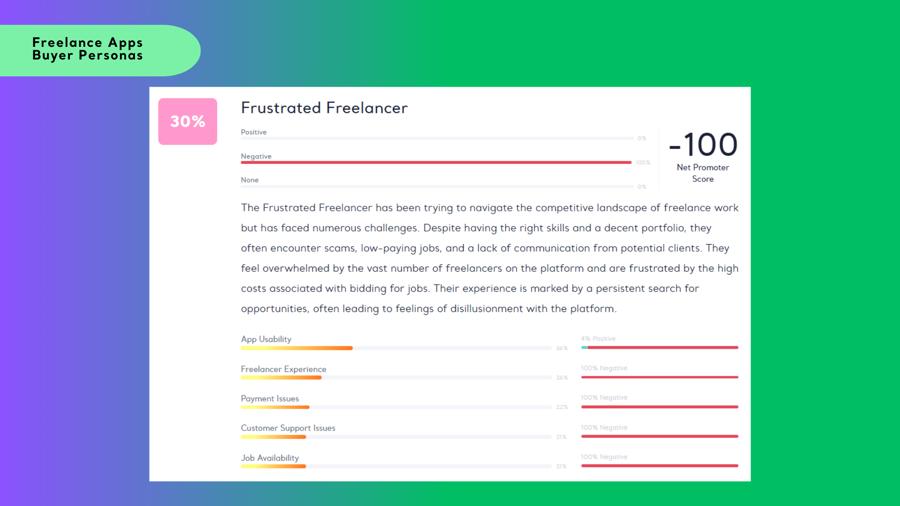
3. Cautious Veteran (11%) – The Experienced Skeptic
A hero who has fought in the freelance world for years and dealt with all kinds of challenges. However, unfortunately, there are sometimes “dead ends” in life. With the skepticism that comes from years of experience, they approach every new job opportunity with “Is this a scam again?” They value reliable jobs and fair payment processes above all else. But still, they march forward, saying, “I’ll find a job, but I need to be careful!” Yes, really careful!
4. Skeptical Client (8%) – The Cautious Investor
A customer who has had a few bad experiences in the freelance world and now fears investing in a freelancer. “How reliable is this freelancer?” they think, and every review and reference is as important to them as life itself. They want a guarantee about the quality of the job and they’re really into that! This customer is absolutely in the “I got burned once, but not this time!” mode.
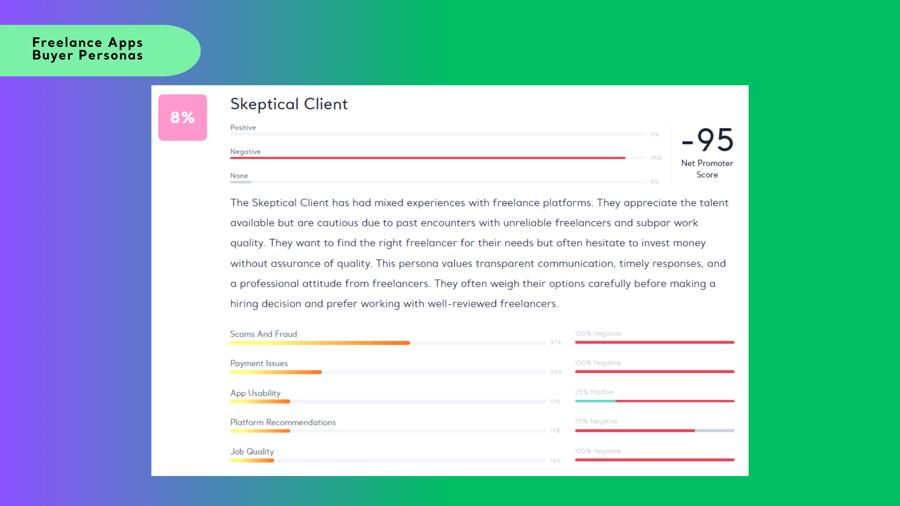
5. Ambitious Achiever (6%) – The Strategic Growth Seeker
A freelancer who is a bit more strategic and a bit more eyes-wide-open. They aren’t afraid of challenges; in fact, they see every challenge as an opportunity. Chasing high-paying projects and growth opportunities, they can’t help but sigh about those “connects”! But hey, everyone pays a price for success, right? So, they continue to work patiently until they reach their goal.
6. Tech-Savvy Guru (5%) – The Innovator in Technology
The child who’s reached the peak of technology! New platforms, features, innovations... Everything is a playground for them. But of course, sometimes platform technical glitches drive them crazy. “Where did this error come from today?” they enjoy questioning. Still, they keep looking out for “Where’s technological development heading?” For them, technology is like a passion.
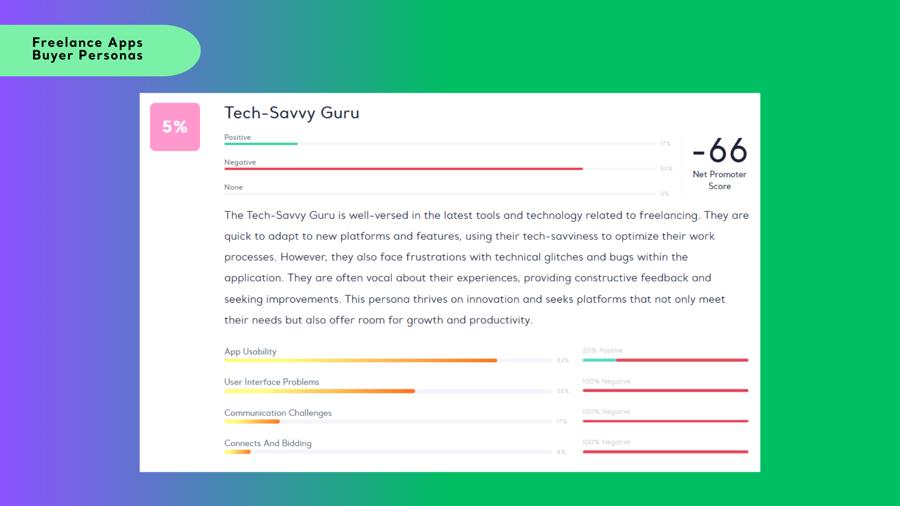
7. Overwhelmed Parent (1%) – The Balancing Act Hero
A hero balancing all their family responsibilities while also trying to pursue their freelance career. Their time is limited, and they go back and forth between family duties and freelance projects, getting more and more stressed due to platform obstacles and lack of customer support. “One minute, one minute, kids, you're late for class, but I’ll finish my work right away!”
These personas showcase the diversity of users on freelance platforms and the obstacles each faces. Some are trying to find work with excitement, while others are only after honest and quality jobs. Each one struggles on their journey, sometimes patient, sometimes frustrated, but always striving to take one more step forward. And we can all relate to them a bit, right?
Building the Perfect Freelance App from User Insights
Popular platforms such as Upwork, Freelancer, and Fiverr, through analysis conducted by Kimola and user feedback, highlight several common challenges and areas for improvement. Based on this data, the features that an ideal freelance application should have are as follows:
User-Friendly Interface and Navigation
An ideal freelance platform should have an intuitive interface that allows users to navigate easily. Platforms like Upwork are generally considered understandable and easy to use by users, but some face challenges such as notification delays and account verification issues. Ideal feature: A simple and clean design, where all platform processes (creating job postings, applying for jobs, receiving payments) can be easily tracked.
Transparent and Reliable Payment System
Payment processes are crucial for freelancers. For example, the "Connects" system in Upwork creates issues for some users, while payment problems are also reported on platforms like Freelancer and Fiverr. Such problems can damage the reliability of platforms and user satisfaction. Ideal feature: A transparent payment system, low transaction fees, secure payment transfers, and easy withdrawal processes should be provided. Additionally, users should not encounter extra fees when receiving payments.
Customer Support Services
Many users express dissatisfaction with the customer support services of platforms. While platforms like Upwork and Freelancer receive poor feedback regarding customer support, some users on Fiverr experience issues with account management or fake job postings. Ideal feature: A fast and accessible customer support team, with a support infrastructure that can quickly resolve user issues. A help center or FAQ section addressing common problems could also be provided.
Protection Against Fraud and Fake Job Postings
Fake job postings and fraud are among the most common issues on freelance platforms. Upwork, Freelancer, and Fiverr receive complaints regarding this, and platforms must implement strong measures to prevent these issues so that users can work securely. Ideal feature: Strong verification processes for detecting fake job postings, a system for users to report suspicious activities, and in-platform security measures should be in place. A stringent verification process and robust anti-fraud tools are necessary to ensure user safety.
Easy Onboarding for New Users
New freelancers often face high competition, paid applications (such as Connects), and difficulties in finding their first job. This can make the initial experience more challenging. Ideal feature: Incentives for new users, such as starting credits or guidance systems, should be provided. This would help new freelancers feel less financial pressure when starting on the platform and build more trust in the platform.
Good Job Matching and Posting System
In freelance platforms with high competition, it is crucial for freelancers to apply for the right projects and match with the right employers. For instance, the Connects system in Upwork and the variety of job postings on Fiverr sometimes make it harder for users to find the right opportunities. Ideal feature: The project matchingsystem should highlight job opportunities that align with freelancers’ skills, avoid excessive competition, and provide equal opportunities to increase the chances for new users.
Feedback and Rating System
Users highly value the feedback of other users when looking for the right job or freelancer. However, issues like fake reviews and rating manipulation can negatively affect the platform’s reliability. Ideal feature: There should be a reliable rating system where users can leave honest feedback for both employers and freelancers, but strict measures should be in place to detect and prevent fake reviews.
Conclusion & What's Next?
Freelance platforms are constantly evolving and changing, based on user feedback. Platforms like Upwork, Freelancer, and Fiverr bring freelancers and employers together, but they also come with some challenges. High commission rates, lack of customer support, security issues, and fraud are common problems. As a result, both freelancers and employers are looking for more reliable and stable platforms.
A successful freelance platform should understand the needs of its users by offering transparent pricing, fast customer support, secure payment systems, and anti-fraud mechanisms. This way, freelancers' earnings can be secured, and employers can work with trustworthy professionals. This lays the foundation for a sustainable freelance ecosystem.
Kimola automatically collects customer feedback from major platforms such as the App Store, Google Play, X, Trustpilot, Tripadvisor, Amazon, and Google Business—transforming it into qualitative research reports with thematic analysis, sentiment breakdowns, buyer personas, usage motivations, and key insights.
If you're ready to take your business to the next level—making it more intuitive, accessible, and aligned with your users' expectations—create a free account on Kimola and start analyzing customer feedback instantly. Want a deeper dive? Request a demo with one of our professionals to explore how Kimola's powerful analytics can help you turn user insights into smarter business decisions.


